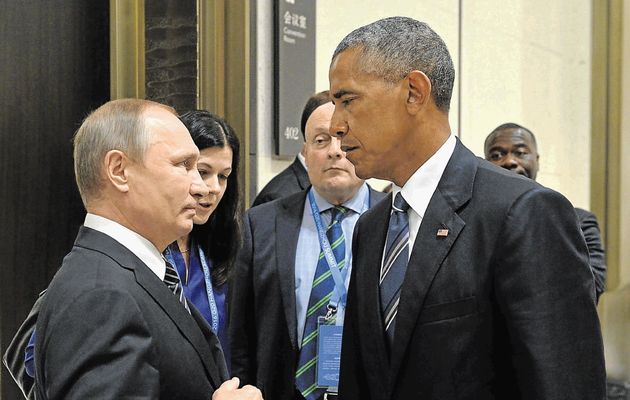A ‘death stare war’ in Hangzhou turned into the Syria deal

Barack Obama met — and stared at — Vladimir Putin in Hangzhou
The Syrian conflict is not over yet. The ceasefire has not yet begun but the United States and Russia have at least agreed that this – the week of Eid al-Adha – can be the start of a new season of hope in the 5-year-old conflict.
No one could have predicted this outcome when the US and Russian presidents met at the Group of 20 summit in the Chinese city of Hangzhou about a week ago. It is understood that Barack Obama and Vladimir Putin discussed the proposed deal but their body language did not signal they might be close to agreement.
Amusingly, both men were captured by a photographer in “a death stare war”, as social media has been calling the intense fixity of their expression.
And yet, the Americans and Russians have agreed to renew the ceasefire in Syria, beginning September 12th. There is to be a cessation of all air and ground attacks by all parties, including the forces of President Bashar Assad’s regime.
This is good news except that it is heavily larded with caveats and caution. When US Secretary of State John Kerry and Russian Foreign Minister Sergei Lavrov announced the deal in Geneva early September 10th after half-a-day of talks, they could not even muster enough hyperbole to call it a turning point.
It is a possible turning point, they said, after years of a brutal war, the deaths of more than 400,000 people, the displacement of millions and a global refugee crisis that has caused political ructions in Europe and the West.
Somewhat dispiritingly, Kerry and Lavrov made clear that trust was in short supply but opportunities must be seized. “No one is building this based on trust,” said Kerry. “It is based on oversight, compliance, mutual interest. This is an opportunity and no more than that until it becomes a reality.”
Will it? Can the ceasefire slowly wind down Syria’s war, force out the extremists, allow time to bind wounds and rebuild shattered communities in their bombed-out cities?
Those who speak from experience say it can be done, if there is enough international political will.
Muhamed Sacirbey, a former Bosnian foreign minister and Bosnia and Herzegovina’s first ambassador to the United Nations, was party to the 1995 Balkan peace negotiations in Dayton, Ohio.
In Syria’s suffering, he sees parallels with his own country.
In Aleppo, Syria’s largest city, he sees a tragic twinning with Sarajevo in 1992, when the Serbs were inflicting what would become the longest siege of a capital city in the history of modern warfare. But NATO acted, albeit belatedly, said Sacirbey, and innocent Bosnian civilians were saved.
The same must happen for Syria, even though military intervention has become a deeply unpopular concept in the decades since NATO’s proactive stance in Bosnia. Iraq and Libya have made it unfashionable to suggest that foreign forces can – and should – use all available means to save civilian lives and stop the bloodshed. However, even limited intervention would save hundreds of Syrian lives each week, particularly with the ending of the biggest driver of death and displacement — indiscriminate air strikes.
A “no-bombing zone” established by the United States and a coalition of allies would protect civilians from the brutality of Assad’s forces. And perhaps it might prompt the regime to consider a creative political solution that allows Syria to be rebuilt.
Perhaps. Lavrov said the regime in Damascus was in agreement and that Russia will do “what depends on us (but) not everything does.”
He has a point. And yet the onus will be on the Russians to nudge Assad towards a vision of Syria that is in a more tranquil state than the temporary cessation of war.
Without the Russians delivering, this deal is a non-starter.

